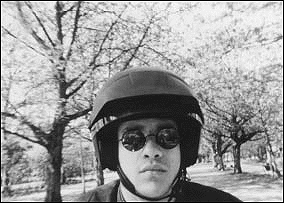|
|
|
監督・撮影:ヨハン・ファン・デル・コイケン
Director, Photography : Johan van der Keuken |
1938年アムステルダム生まれ。12歳より写真を撮り始め、1955年に写真集「We are 17」を発表。奨学金を受けてフランスの高等映画学院(IDHEC)に学び、1960年『Sunday』からドキュメンタリー映画を手掛ける。以来『Blind Child』(1964)、『Big Ben / Ben Webster in Europe』(1967)、『The White Castle』(1973)、 『Flat Jungle』(1978)、『The Way South』 (1980-81)、『I Love $』(1986)、『Brass Unbound』(1992-93)、などの作品で、オランダを代表するドキュメンタリー作家としての地位を築いている。『井戸の上の眼』 (1988)では1989年本映画祭のコンペティション部門優秀賞を受賞。映画批評でも健筆を奮い、また写真家としても活躍。 Born in 1938 in Amsterdam. Started photography at the age of 12, and published his first book of photographs We Are 17 in 1955. He won a scholarship and studied at France's Institut des Hautes Etudes Cin?atographique (IDHEC, National Film Institute) in Paris, and directed his first documentary Sunday in 1960. Established himself as the Netherland's leading documentary filmmaker with his films including Blind Child (1964), Big Ben / Ben Webster in Europe (1967), The White Castle (1973), Flat Jungle (1978), The Way South (1980-81), I Love $ (1986), Brass Unbound (1992?93), His The Eye Above the Well (1988) was awarded one of the Two Runner-Up Prizes at 1989 Yamagata Festival. Also known as a film critic and a photographer. |
 |
|
| 冷戦後、世界中で移民が爆発的に増加、大都市は“国の首都”としての顔とは裏腹に、人種のるつぼと化しつつある。ことEC体制で国境の消えつつあるヨーロッパの都市、それも西欧=東欧=北欧を結ぶ交通の要衝アムステルダムとなればなおさらだ。モロッコ出身のバイク宅配便の青年を案内役に、出産を控えたボリヴィア人とオランダ人の夫婦、チェチェン出身の実業家、ローラーブレードに興じる少年たち、ボスニア出身のロックバンド、ホロコーストを生き延びたユダヤ人親子…。カメラは様々な人々と出会い、時には彼らの世界に踏み込んでその故郷にまで旅立ち、歴史を逆上る。ヨハン・ファン・デル・コイケンは40年近いキャリアをもつベテランならではの熟練さで、この現代を生きるための共生のメッセージを強く唱えつつ、自らの操るカメラの繊細な躍動と、ジャンプカットを大胆に多用したリズミカルな構成で、現代都市アムステルダムの肖像を若々しく映し出している。 (水原文人) |
In the wake of the explosive increase of world migration after
the Cold War, behind the mask of being the capitals of nations,
large cities are becoming racial melting pots. This is particularly
true in Europe, where the EC system is erasing national boundaries
between its countries, and especially in the case of Amsterdam:
a pivotal city connecting traffic from Western, Eastern and Northern
Europe. Guided by a Moroccan born moped courier, we are shown
into the lives of Amsterdammers. From a Bolivian-Dutch couple
expecting a child, a Chechen entrepeneur, roller-blading youngsters,
and a Bosnian rockband, to a Jewish parent and child who survived
the Holocaust, the camera encounters numerous people, sometimes
even venturing afar into " their worlds, " travelling to their
homelands and tracing their history. A veteran master of close
to forty years, Johan van der Keuken strongly advocates a message
of coexistence in order to live in this day and age. With the
dynamism of his filming, and his rhythmical editing style, Keuken's
portrayal of Amsterdam as a city of our time is filled with youthful
vitality. - Mizuhara Fumito |
|
|
|
|
監督のことば 我々の旅は都市を3つのレヴェルで通り抜ける―水の上、地上、そして空中を。運河の描く同心円状の環、季節の循環に沿った運動の上に、すべての出会いが位置し、つながっている。この構造が私の映画の土台となって、即興の自由を与えてくれた。 我々は運河を、水の上を運ばれる。カメラは水面を滑り、その高さから都市を見つめ、河岸の生活に、その家々に、船舶に入り込む。建物のファサードが作り出す無限に多様な建物の空間を見上げる。そして何であろうと興味を捉えるものがあれば、そこに焦点を合わせる。 我々は地上を移動する--徒歩で、自転車で、運河に沿って走る自動車で。そして我々は都市生活の中へ--他の人々と共に歩き、バイクで信号を無視し、混雑した道の車や市電の合間をジグザグに擦り抜け、交通渋滞に巻き込まれ、路上の生活をクラクションを鳴らす車の列から見る。そして何であろうと興味を捉えるものがあれば、そこに焦点を合わせる。 我々は都市の上空を飛ぶ、屋根と水路の織り成す比類ない模様の上を。旅から帰ってくる度に息を呑む光景だが、今回は着陸はしない。我々は空中を昇りつめる、都市の上、雲の上高く、そして空中を押し流される--東へ、西へ、南へ--この都市の新しい住人たち、水上と地上で既に会った人々の、その故国へと。経済的に、文化的に隔てられた異なったはずの世界が、分かちがたく互いに編み込まれていく。 |
Director's Statement Our voyage takes us through the city on three levels: over water, on the ground and through the air. Movement along the concentric rings of the canals, through the circle of seasons upon which all encounters are located, connected. This structure is the basis of my film, a solid foundation that permits me the freedom of improvisation. We are carried through the canals, located on the water. The camera glides, looking at the city from the water's surface, taking in the life on the quayside, in the houseboats and vessels. It looks up into the architectural space formed by the endlessly varied stream of fa溝des. And whenever something happens that catches our attention, we bring it into focus. We are moving at ground level: walking, cycling, or motoring in a car alongside the canals. Then we are amidst city life: pressing on with other pedestrians, skipping traffic lights on bike, zigzagging between cars and trams on busy side streets, or crawling along in a traffic jam, seeing street life from a queue of hooting cars. And whenever something happens that catches our attention, we bring it into focus. We are flying over the city, above the unique pattern of roofs and waterways. It remains breathtaking every time we come home from a journey, but this time we do not touch down. We climb into the air, high above the city, above the clouds, and we are hurled away through the air--eastward, westward, southward--to the countries of origin of the new citizens of the city, to those whom we have already met on the water and the ground. Separated by economic and cultural differences: different worlds irrevocably interwoven. |
